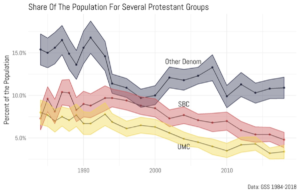By: Ryan P. Burge – christianitytoday.com – May 24, 2019
By now, Southern Baptists recognize that their movement is in a decline that shows no signs of changing course.
By their own measures, they’re not adding as many new believers to their flocks each year—the Southern Baptist Convention (SBC) went from baptizing 321,000 in 2007 to 246,000 last year.
Plus, despite adding more than 10,000 more cooperating churches over the past couple of decades, church attendance across the denomination is also dropping.
In 2006, the SBC had 16.3 million members, now that’s down to less than 15 million, according to the denomination’s most recent Annual Church Profile (ACP).
Outside surveys have also tracked the decline. New findings released this year show the Southern Baptist trajectory more closely resembles the downward trend among the United Methodist Church (UMC), the nation’s largest mainline Protestant body, than fellow evangelicals in non-denominational traditions.

According to the General Social Survey (GSS), nearly the same percentage of Americans identified with the SBC as the UMC in the 1980s, then the two denominations’ trends began to separate, and both experienced a slow, steady decline from the mid-’90s on.
While close to 1 in 10 Americans identified as Southern Baptist in 1987, that number has been cut in half to 1 in 20 (4.8%) in 2018. Data from the Cooperative Congressional Election Study (CCES) reinforces this point as well, with 5.4 percent of the sample identifying as SBC.
There are four major ways for a religious denomination to change in size over a longer period of time: They add members through conversions, they keep those born into the faith as they grow up, they shed members through people defecting to other religious traditions, or members die and are not replaced by young adults.
Every religious group experiences these losses to some extent—like a bucket that has sprung a few leaks. While some of the water will inevitably trickle out, it’s possible to put more water back in the bucket from other sources. If the amount of water that leaks out is greater than the amount of water that is replaced, then a decline will occur in overall members. The Southern Baptist Convention has a bucket that is aging and springing more leaks every year.
Conversion and Defection
As evangelicals, Southern Baptists put particular emphasis on conversion as a potential source of membership growth and celebrated around a quarter of a million baptisms last year, according to ACP figures. However, nearly all Southern Baptists have been part of the denomination for a while.
CCES, which tracked the same group of 9,500 respondents in 2010, 2012, and 2014, found few newcomers to the SBC during that time. Of the 476 Southern Baptists in the sample in 2014, close to all of them (97.9%) had also identified as Baptists in 2010. Of those who converted to the SBC, two had been Catholics, two were from other faiths, and six had been religious “nones.” These numbers are too small to make claims about converts from any specific group, but the overall impression is clear: Southern Baptists are not seeing significant growth through conversion.
The necessary follow-up question, then is: Are a lot of Southern Baptists leaving the faith? CCES data also showed that 91.8 percent of people who started out as SBC in 2010 were still SBC four years later. Of the 37 people in the sample who left the SBC between 2010 and 2014—not a significant enough portion to extrapolate—31 of them either became a non-denominational Protestant or some other type of Protestant Christian. Just two became “nones.” Obviously, any defection is disappointing for those who want to see the SBC grow, but based on this sample, of the members who do leave, they often don’t stray too far.
Births and Deaths
The last two factors around shifts in the denomination have to do with whether enough children born into Southern Baptist families remain in the church—or return as adults—to offset the eldest generation, which is dying off.
Recent research by University of Oklahoma sociologist Samuel Perry concluded that evangelical Protestants have seen a decline in fertility in recent years. It’s a well-known phenomenon that young people drift away from church attendance in their 20s and 30s but return when they get married and have children.
The GSS, which asks respondents about their current religious affiliation as well as what religion were they were raised as, shows that fewer Southern Baptists are sticking with their parents’ denomination.
For much of the ’80s and ’90s, Southern Baptist kids were pretty likely to grow up to become Southern Baptist adults: Seven in ten maintained their SBC identity into adulthood in surveys conducted between 1984 and 1994.
That has declined precipitously. In the most recent surveys conducted between 2015 and 2018, just over half of those raised Southern Baptist were still with the SBC. In other words, nearly half of Southern Baptists kids leave and never come back.
To see the remainder of this article, click read more.
Source: Only Half of Kids Raised Southern Baptist Stay Southern Ba…… | News & Reporting | Christianity Today
 Listen Online
Listen Online Watch Online
Watch Online Find a Station in Your Area
Find a Station in Your Area









 Listen Now
Listen Now Watch Online
Watch Online
